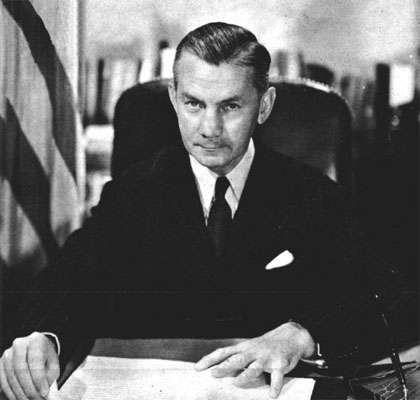
The Mysterious Death of James Forrestal: Suicide? Murder? Accident?
Nick Redfern July 19, 2021
My previous article was about the CIA, it’s 1950s-era “assassination file,” and the still-mysterious 1962 death of Hollywood legend, Marilyn Monroe. Today, I’m going to focus on another aspect of that Cold War-era file. This one on the matter of death from a high fall. The document states, in part: “The most efficient accident, in simple assassination, is a fall of 75 feet or more onto a hard surface. Elevator shafts, stair wells, unscreened windows and bridges will serve. Bridge falls into water are not reliable. In simple cases a private meeting with the subject may be arranged at a properly-cased location. The act may be executed by sudden, vigorous [excised] of the ankles, tipping the subject over the edge. If the assassin immediately sets up an outcry, playing the “horrified wit ness”, no alibi or surreptitious withdrawal is necessary. In chase cases it will usually be necessary to stun or drug the subject before dropping him. Care is required to insure that no wound or condition not attributable to the fall is discernible after death. Falls into the sea or swiftly flowing rivers may suffice if the subject cannot swim. It will be more reliable if the assassin can arrange to attempt rescue, as he can thus be sure of the subject’s death and at the same time establish a workable alibi.” The CIA document continues: “Falls before trains or subways are usually effective, but require exact timing and can seldom be free from unexpected observation.”
 Now, with all of that in mind, let;s have a look at a very controversial death that occurred in 1949 and that could easily have been achieved by using the rules above. May 22, 1949 was the date on which the first U.S. Secretary of Defense, James Forrestal, died. Specifically at 1:50 a.m. As will quickly become apparent, the circumstances surrounding Forrestal’s final hours are swamped in controversy. All that we know with absolute certainty is that in the early hours of the 22nd, Forrestal’s body was found on a third-floor canopy of the Bethesda Naval Hospital, Maryland. Did he take a fatal leap out of the window of the 13th floor of the hospital, his mind in turmoil and suicide on his mind? Was it an accident? Or, was Forrestal assassinated? April 2, 1949 was the date on which Forrestal was taken to the hospital – for his own good and for that of the U.S. government, too. Forrestal’s mind had been fragile for a while, But, then, following a full-blown breakdown, Forrestal needed expert care. He got it. For a while. Things suddenly, and terribly, changed on May 22, 1949. Death was just around the corner. It was a death shrouded in mystery. Let’s see what we know for sure about those final hours for someone who held some of the U.S. government’s most important secrets. The man assigned to keep a careful watch on Forrestal was Edward Prise. He was a U.S. Navy corpsman. Such was the length of their time spent together, the pair became good friends. As the night got longer, Forrestal told Prise that he didn’t need a sleeping pill and was going to dig into a book for a while. That too was a good thing. Or, at least, it seemed to be that way. After Prise’s shift was over, he was replaced by another military man, Robert Wayne Harrison, Jr. Forrestal’s end was almost upon him.
Now, with all of that in mind, let;s have a look at a very controversial death that occurred in 1949 and that could easily have been achieved by using the rules above. May 22, 1949 was the date on which the first U.S. Secretary of Defense, James Forrestal, died. Specifically at 1:50 a.m. As will quickly become apparent, the circumstances surrounding Forrestal’s final hours are swamped in controversy. All that we know with absolute certainty is that in the early hours of the 22nd, Forrestal’s body was found on a third-floor canopy of the Bethesda Naval Hospital, Maryland. Did he take a fatal leap out of the window of the 13th floor of the hospital, his mind in turmoil and suicide on his mind? Was it an accident? Or, was Forrestal assassinated? April 2, 1949 was the date on which Forrestal was taken to the hospital – for his own good and for that of the U.S. government, too. Forrestal’s mind had been fragile for a while, But, then, following a full-blown breakdown, Forrestal needed expert care. He got it. For a while. Things suddenly, and terribly, changed on May 22, 1949. Death was just around the corner. It was a death shrouded in mystery. Let’s see what we know for sure about those final hours for someone who held some of the U.S. government’s most important secrets. The man assigned to keep a careful watch on Forrestal was Edward Prise. He was a U.S. Navy corpsman. Such was the length of their time spent together, the pair became good friends. As the night got longer, Forrestal told Prise that he didn’t need a sleeping pill and was going to dig into a book for a while. That too was a good thing. Or, at least, it seemed to be that way. After Prise’s shift was over, he was replaced by another military man, Robert Wayne Harrison, Jr. Forrestal’s end was almost upon him.
 James V. Forrestal
James V. Forrestal
At some point into his shift, Harrison, Jr. left the room to run an errand. From that point onward, everything very much becomes murky, unclear – and probably something that will never be fully resolved to the satisfaction of everyone. When Harrison, Jr. got back to the room he was shocked to the core to see that Forrestal was not in his bed. And, the room’s windows were open. Harrison’s Jr raced to the window: the cord of Forrestal’s dressing-gown was tied to the radiator near the window. Clearly, the goal was death by strangulation. It turned out, however, that Forrestal’s weight caused the cord to snap and Forrestal fell ten floors to his death; something that absolutely no-one could have had a chance of surviving. The official theory is that Forrestal – left all alone in his room – took his own life, possibly in a brief moment when his mind swung back to that dangerous state of depression and anxiety. The big question, however, is: could Forrestal have been pushed? The reason: to make sure he could never, ever reveal what he may have been exposed to in government? An accident? Murder? Suicide? We’ll probably never know.
MU*



















